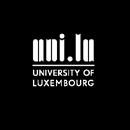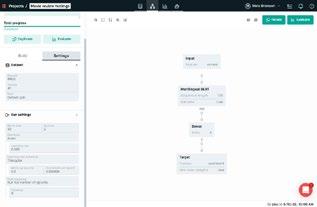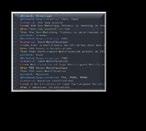National Centre of Excellence in Research in Financial Technologies

ICT solutions that are secure, compliant and trustworthy are a core component of the financial, asset management and insurance sectors. They’re also within the fabric of the work we do. Our research within the FinTech domain surrounds cybersecurity, blockchain, artificial intelligence, machine learning, law, finance alongside many other areas, as we help to develop the financial services and products of tomorrow.
3
We are your FinTech experts
Financial services is the key sector within the Luxembourg economy, and has been progressively undergoing a digital transformation. Over the last few years, FinTech has revolutionised the industry, forcing an interlacing of traditional business approaches with innovative, cutting-edge technologies. With its vibrant ecosystem of financial institutions, research and development centres and companies specialising in advanced technologies have propelled Luxembourg’s reputation as an emerging FinTech hub.
SnT and FDEF from the University of Luxembourg play an active role in supporting the FinTech sector through research, technology transfer and education. Throughout the years, we have worked closely with banks, insurance companies, FinTechs and the financial regulator to bring innovative solutions to financial services. Luxembourg
Where innovation meets finance
• Rich and supportive business environment, the perfect gateway to the EU for international FinTechs.
• Tech friendly regulatory environment helps FinTech projects to flourish.
• Home to many FinTech activities: DLT T echnologies, InsurTech, RegTech, mobile payments, security and more.
• The largest investment fund centre in Europe and the second largest in the world after the US.
National Centre of Excellence in Research in Financial Technologies
The digital transformation is poised to have a substantial impact on Luxembourg’s most important industry – finance. For the financial industry to keep pace as new technologies change, not only consumer expectations but also regulatory demands, the sector needs more structured scientific support.
Vision
Strengthen Luxembourg’s position as an innovative financial hub by attracting talent and providing world-class research and education.
The National Centre of Excellence in Research in Financial Technologies (NCER-FT ) is an interdisciplinary centre that looks deeply into the financial industry’s technological challenges and opportunities. It provides much-needed thought leadership, scientific insights, and practical training. Led by researchers from the University of Luxembourg’s Interdisciplinary Centre for Security, Reliability and Trust (SnT), the Department of Law (DoL), and the Department of Finance (DoF), the NCER-FT implements a uniquely interdisciplinary research approach, combining expertise from technology, finance, and law. This interdisciplinary research
approach is not only essential for developing practical, sustainable solutions to the challenges of digitalisation in finance, but is also unique in the world.
The NCER-FT fosters a culture of cross-pollination between top researchers and Luxembourg’s financial services industry. Research conducted at the centre follows SnT’s rich tradition of collaborative research, wherein industry partners and university researchers work together on bi- or multi-lateral research projects.
5
4
In the framework of the FNR ’s INITIATE funding instrument, we conducted a feasibility study for the NCER-FT . During this study, we identified key research topics that are relevant for addressing industry needs, and will benefit most from our consortium’s relevant areas of expertise. These topics are:
Potential research projects
New frontiers for digital and automated finance
RegTech and compliance by design

While many aspects of the NCER are already in place within the consortium members, one element that should be strongly fostered through the NCER is transdisciplinary work between SnT and FDEF Therefore, we defined a portfolio of initial projects with the following objectives:
Financial inclusion Trust and security
• As a priority, initiate interdisciplinary work between scientists at SnT, DoF and DoL
• Launch research activities that are necessary but will not attract partner co-funding
• Quickly start activities targeting the acquisition of partners
• Increase the national and international visibility of the NCER
• Develop research infrastructures (datalake, demos, etc.)
The pages 8 – 21 detail potential research projects planned to launch quickly in the ramp-up phase. The pages 24 – 28 will detail five demos of past projects with partners.
7
RUMOFA: Runtime Monitoring of Fund Activities

FinSAT: Automated Investment Advice using AI on Satellite Data
Prof.
Contact: hayder.al-hraishawi@uni.lu
Project Description
- Monitoring fund activities with respect to financial regulations and fund documents (e g , prospectuses) is essential to protect fund investors and ensure well-functioning asset management markets
- This project aims at developing an automated, scalable, and accurate approach for monitoring fund activities by introducing established software engineering techniques in the financial and legal domain
Motivation
Financial service providers will improve their businesses by developing novel investment strategies using satellite data.

Feature engineering and multi-feature analysis will empower AI algorithms to make automated investment advice
Various learning algorithms will ensure that the AI system adapts to new data and improves investment decisions over time.
Objective
Objectives
Automated Metadata Extraction
AI-based extraction of metadata and structured requirements from financial regulations and fund documents

Automated Monitoring and Verification

Automated monitoring and verification of financial transaction records against the requirements extracted from the above
Methods
Interpretation of financial regulations and fund documents related to the financial transaction records to be analyzed
Leveraging Natural Language Processing (NLP) and Machine Learning (ML) for metadata and requirement extraction
Application of Runtime Verification (RV) techniques to the financial transaction records with the help of log parsing approaches


To develop AI-based financial solutions that incorporate data analytic outcomes to predict future market returns with interpretable decision logic that can support asset management strategies.
Data and Analysis
• Using the SnT Satellite Traffic Emulator and its temporal data models


• Collecting traditional data from socioeconomic databases
• Exploiting the Spire Data Lake including vessel and flight tracking.
AI-based Fin. Solutions
• Finding signals that create abnormal investment returns and building a realistic showcase.
• Extracting maritime transport information from satellite data to be translated into indicators in the finance domain.



Impact and Beneficiaries
• Solutions relevant to any local asset manager
• Open up new use cases for satellite data in investment strategies.
• Potential collaboration with the Satellite and FinTech companies in Luxembourg.

- Fostering the application of (semi-)automated compliance (and supervision) technologies in the field of asset management
- Next-generation real-time regulatory compliance and its economic and legal implications














- Regulators (e.g., CSSF)
- Public actors (e.g., IOSCO)



- Private institutions (e.g., banks)
• Employing of AI and Learning techniques to extract value from massive unstructured datasets to make predictions about their relative profitability.
9
Prof. Symeon Chatzinotas, Dr. Eva Lagunas, Dr. Hayder Al-Hraishawi, Dr. Wallace Martins (SnT-SigCom)
Michael Halling (Dept. of Finance)
Risk Management Drive Efficiency Uncover Opportunity
New frontiers for digital and automated finance 8
D. Bianculli (SnT), M. Halling (FDEF), S. Abualhaija (SnT), D Shin (SnT), N. Sannier (SnT) University of Luxembourg
Impact Potential Partners
A1. Financial Metadata Extraction A2. Representation of Fund-related Requirements A3. Monitoring and Verification of Financial Transactions Fund Documents Financial Regulations Financial Metadata Structured Requirements Financial Transaction Records Monitoring and Verification Results Fund NAV % Fund Document govern Financial Regulations Investors Share subscribe Financial Transaction Records Initial subscription? YES RUMOFA Apply sales charge percentage of 3% FDEF SnT SnT SnT FDEF New frontiers for digital and automated finance
IDOML: A platform for the Integration, Development and Operations of Machine Learning systems


D@A – Digital market for tokenized data
Zsófia Kräussl(DoF) Denitsa Stefanova (DoF), Radu State (SnT) University of Luxembourg
Hurdles in adopting Machine Learning
Restrictions in innovationbudgets
Lackof in-houseknowledge
Aversions to technology risks
andothers
The ultimate objective of this project is to lead the whole financial industry inits adoption of ML technologies

Project Objective
IDOML, a softwareplatformthat supports research and development activities at the intersection of ML andfinance.




Automates ML developmentprocess
Basedonestablishedtechnologies
Offthe shelf,opensource,flexible,extensible




Enables the explorationof ML research
Tailored tothe financialindustry

Output: Tooled Automations

Research that IDOML will enable
Why don’t you sell your own data?
Is there a business case?
Robust to new and unexpected conditions
Techniques to make Financials ML models: Compliant to regulation requirements

Open to traceability in their decision making
Monitored throughout their lifecycle
IDOML will serve as an off-the-shelf solution for in-utero data science labs that is affordable, practical, and supportive of the NCER research.
• Dataprotectionrulespushindividuals to comprehend implications ofsharing own data

• Turningdata into asset puts the implications of datatrade in thehandsofdataowners
What is your data worth?
Trusted data trade by market design

• Wrongincentivesboostopportunism
• Carefully designed pricing mechanism minimize risk and control trading behavior
Data as tokenized asset
• Raw, tangible, structural
• Blockchain Technology is our toolset to tokenize
• Privacy and security are digitally feasible concepts
• Market mechanisms are coded ex-ante
Trading data for propercredit risk assessment?
Trusteddata governancefor supplychainfinance? ©medium.com
Inter-disciplinary effort toward both financially & technologically feasible digital markets

Data as perceived signal
• Unstructured, sentiment-based
• Meaningful for trading action
• Correlated information signals influence data perception
• Different perception might ead to different valuation
Data market
• Ex-ante mechanism design requires understanding the fundamentals of an asset
• Market design is captured by Finance research
• Market mechanism is captured by CIS research
11
dataA dataA signalA signalB ©j-mel - stock.adobe.com
New frontiers for digital and automated finance 10
Adriano Franci Thibault Simonetto, Dr. Renaud Rwemalika, Dr. Maxime Cordy SnT University of Luxembourg
Trust and security New frontiers for digital and automated finance
Enabling non-expert Data Fusion, Machine Learning and Analysis through no-code tools for the FinTech domain
CryptoReg: Regulating Crypto-assets
Prof. Dr. Dirk Zetzsche, ADA Chair in Financial Law (financial inclusion), FDEF/DL Prof Dr Silvia Alegrezza, FDEF/DL Prof. Dr. Gilber Fridgen, PayPal Chair, SnT
Democratising Data analytics, Classification and Prediction
Current state-of-the-art in low/no-code machine learning

Description
Crypto-asset as technical innovation challenges for law and regulation
Law and regulation of crypto-assets preconditionfor pricing, custody institutionalinvestments, listing






EU law on crypto-assetsat infancy vagueness, uncertainty
Decentralized finance as technical frameworkfor legalanalysis
Issues
• ML-expertise still needed
• No data fusion support
• Domain knowledge not reflected
Project Objectives
• No-code tools to perform data fusion and model exploration

• Supporting anonymisation at the source
• Synthetic data generation based on data origin.
• Test the tool feasibility with Finance professionals.
• Validate output performance with ML experts.
Problem-specific data collection and modelling for financial decision-making.
Interdisciplinary cooperation
• Domain expertise from DoF


• Scientific ML expertise at SnT.


• Integrating FDEF students for experiments.
Research activities for NCER
• Embracing open source
• Integral for NCER Fintech data-lake
• Secure access to anonymised data.
Enabling Growth for Luxembourg



Partnership projects
• SnT Partnership with Yoba SA.

• Use of LBR data.
• Use of alternative data (e.g. social media).
Ensuring Legal Certainty
Sound Technical Foundation
• Alternative crypto platforms
• Crypto- nnovation: NFTs, DeFi, DAOs

• Technicalapproachesto legal problems selective privacy through zero-knowledge-proofs
Balancing risks and opportunities
Financial law and Regulation



• Investment and custody by investmentfunddepositaries
• Listing, trading, lendingat stock exchanges


• Transfer amongindividuals
• Private law, insolvency
Proportionate Regulation
AML/CTF/ KYC
Openness to Innovation

• Anti-Money laundering
• Counter terrorist financing
• Know yourcustomers
• Reformed W ire Transfer Regulation
• Tracing crypto-asset flows
Partners: Luxembourg Parliament, CSSF, ALFI, ABBL, law firms, accountants, exchanges, service providers, entrepreneurs
13
Trust and security New frontiers for digital and automated finance 12
Mats Brorsson, SnT, Zsofia Kräussl, DoF University of Luxembourg
Trust and security New frontiers for digital and automated finance
FinTech for Renewable Energy Markets (FinER)
Prof. Gilbert Fridgen, SnT, University of Luxembourg
Prof. Nils Löhndorf, Depmt of Econ. & Mgmt, FDEF, University of Luxembourg




Description









Digitalization of energy systems and markets is a key enabler for reaching the EU's climate goals. Renewable power purchase agreements (PPAs) are an increasingly popular instrument to finance renewable energy projects. However, there are no financial instruments to hedge the captured price of renewable PPAs, which limits their use in financing investments in renewables. This project investigates the feasibility of “renewable power futures” as financial derivatives for renewable PPAs. A particular focus will be the feasibility of using smart contracts to encode PPA properties and ensure proof-of-origin.
The goal: Develop renewable power futuresas smart contractsand investigate theirapplication for hedging the pricerisk of renewable PPAs
Renewable Power Futures
• Encode renewable power futures as smart contracts with dynamic load profiles.
• Contrasts rigid contracts with static load profiles.
• Encode PPA characteristics n a standard manner, allowing for standard pricing formulae.


• Attach proof-of-generation to smart contract as immutable proof-of-origin.



• Non-fungible tokens (NFTs) and distributed ledgers as possibletechnologies.
RegCheck: Program analysis for regulatory compliance assessment of FinTech Software
J. Klein (SnT), S. Tosza (FDEF), T. Bissyandé (SnT), D. Bianculli (SnT), S. Abualhaija (SnT) University of Luxembourg
Project Description
RegCheck aims at developing a tool that facilitates compliance checking of software systems against data protection regulations (e g , GDPR)




Project Output
Outlook
• Early cooperation with Luxembourgish energy companies (Encevo, Enovos)
• Mid-term collaboration with tech startups (Nexxtlab, DataThings)


• Long-term goal: integrate FinER into ecosystem of investments in renewable energies (Green Exchange LGX, Alma Solar).

Expected Impact
• Contributing to "Compliance by Design"
Compliance checking of software systems against regulations


• Bringing together software concerns and regulatory compliance concerns (multi-disciplinary)

• Providing tool support to be integrated in the NCER date lake: compliance checking of apps and services developed as part of the infrastructure


Define user_view(){ Cookie cookies[]=request.getCookies(); String []selected_options = request.getParameterValues(“radio-consent”); if consent_notice is selected, then user_consent = TRUE AND show withdraw_consent_button; send_notification(user_name);}


Potential Partners
• The CSSF
• One or more Big Four companies (EY, Deloitte, KPMG, PwC)
• Software development companies

15
Privacy Regulation (e.g., GDPR) Software Artifacts (e.g., source code) Consent Viewpoint Case Laws
Compliance Checking Rules Objective . Extraction of privacy-related requirements from GDPR and translation of these requirements into rules Objective . Analysis of software artifacts from a regulatorycompliance viewpoint Lawyer Software Engineer If user gives consent: Allow user to withdraw consent
Artificial Intelligence Machine Learning Natural Language Processing Methods Code Search Code Tagging Methods Static Analysis Methods 1 2 3 New frontiers for digital and automated finance 14
Objective
Annual growth rate of PPAs in Europe since 2018 Proof-of-Generation as Smart Contract 17.45 GW* Amazon* Top purchaser of PPAs Installed renewable capacity via PPAs during covid-19 pandemic (2020-21) 42%* Renewable
Futures
Power
Proof of Concept
Market Prototype with Partner Company
Monte Carlo Simulation Model
Financial inclusion New frontiers
and
*Source: European PPA Market Outlook 2022, Pexapark
for digital
automated finance RegTech and compliance by design
ICCOFIDO: Incremental Compliance Checking of Financial Documents
AFRICA: Automated Financial Regulations Change Impact Analysis
L. Briand (SnT), D. Zetzsche (FDEF), S Abualhaija (SnT), M Bodellini (FDEF), D. Bianculli (SnT) University of Luxembourg


Project Description
Project Description
Financial regulations oblige funds to produce and amend various documents, which fall under regulatory supervision.
ICCOFIDO aims to accelerate compliance checking of financial documents by developing a tool for making the process incremental:
After a new document version is produced, ICCOFIDO will enable to perform the minimal set of compliance checks required by the changes
Project Objectives and Methods

Devising a tool-supported approach for:
O1. Automated identification of document metadata changes




Identifying which key data or information has changed in the document and needs to be reverified
O2. Impact analysis of metadata changes on compliance rules








Determining the subset of rules, the evaluation of which is affected by the changes in the document
O3. Incremental compliance verification

Checking only the meaningful set of compliance rules over the changes

Expected Impact
Nowadays, compliance checking of financial documents is a time-consuming, resource intensive and static activity
Instead of performing compliance checking over an entire document, ICCOFIDO would allow:
- Checking selected sets of rules on an incomplete draft document
- Checking only the revised portions of a document
Potential Partners
- Regulators who are responsible for validating the submitted documents


- Management companies during document authoring and in-house compliance checking activities prior to (re)submission

AFRICA aims at detecting the change in financial regulations and analyzing in a (semi-)automated manner the impact of this change on FinTech-related software, directly affecting the compliance of a financial institutions
Project Objectives
Objective 1. (Semi-)automated detection and analysis of financial regulations changes over time.


Objective 2. (Semi-)automated impact analysis of regulations changes on fintechrelated software artifacts, consequently recommendation of adaptation to remain compliant.
Impact
Developing a foundational framework for change impact analysis re financial regulation
Preparing a model for informing financial institutions on future regulatory change
Technically assessing the impact on regulation on an institution's core business



Potential Partners
Public sector (e.g., CSSF, ECB and EMSA)
Private sector, including traditional banks, investment banks, management companies, and FinTech companies

17
on the activities and supervision of institutions for occupational retirement provision Directive (EU)2016/2341 Financial regulations Identification of regulatory changes Software artifacts Change impact analysis Detection and classification of regulatory changes Taxonomy for regulatory change Automatically generated patterns Recommendations towards compliance Use case Directive 2011/61/EU Throughout these regulatory changes: Articles 4, 9, 15, 17, 32, 33 and 61 as well as annex IV have been amended, articles 30a, 32a, 43a and 69a have been introduced, and article 62 was repealed on markets in financial instruments Directive 2014/65/EU Directive 2013/14/EU on over-reliance on credit ratings with regard to cross-border distribution of collective investment undertakings and Directive (EU) 2019/2034 on the prudential supervision of investment firms. Directive (EU)2019/1160 laying down general framework for securitisation and creating a specific framework for simple, transparent and standardised securitisation Regulation (EU)2017/2402 was amended by 2013 2014 2016 2017 2019 FDEF SnT FDEF SnT RegTech and compliance by design 16 Document v1 Document V2 Compliance checking over the identified rules Identify the changes Compliance Rules Identify the subset of rules to reevaluate O1 O2 O3 Artificial Intelligence Software Engineering Law and Regulatory Compliance Compliance Report Incremental Compliance Checking Rules to Reevaluate Change Impact Analysis Compliance Rules Metadata Change Analysis Fund Document Metada Extraction Document Metadata Modified Metadata
Prof. Domenico Bianculli (SnT), Prof. Stanislaw Tosza (FDEF), Dr. Nicolas Sannier (SnT) University of Luxembourg
RegTech and compliance by design
AFS: Auto Fund Set-up
Prof. Dr. Dirk Zetzsche, ADA Chair in Financial Law (inclusive finance), FDEF/DL


Prof. Dr. Yves Le Traon, SnT
Vision: a fully automated fund –set-up Establishment
15,000 undertakings for collective investments holding EUR 6 trillion in assets, providinga third of Luxembourg’S GDP, wait for automatisation
The undregistration process as well as the adjustment of the fund’sconstituting documents to legislative changes is a major cost for Luxembourg’s investment funds.
AFS to provide cost-efficient automatedsolutions for the Luxembourg fundindustry.
Prototype as envisionedoutput.
Makinguse of the PotentialofRegulatoryTechnologies (RegTech)
Digitalization as CompetitiveAdvantage
To automatefundregistration,includinglegalcomplianceandchange-impactpropagation

Leveraging well-establishedtechnologiesforbusinessprocessautomation (BPM, rule-basedtechniques)
Addingthe keyadvancedtech ingredients (AI,NLP, Model-Driven Engineering) Being adaptive to frequentchanges in the legislation andlargeconfigurationspace(SoftwareProductLine)



Law and Regulation
• Law as a cost factor to he Luxembourg fundindustry

• Manyadjustmentsto law and regulation followsimple patterns (boilerplate)




• AFS to provideautomated solution for moststandard adjustmentsto law and regulation


Technology
Goal: Automatingthe process
How?
• Rule-basedapproaches and model-driventechniques
• SPL for controllingthe configuration space and consistencychecking

• Advanced AI-enabled solutions, includingNLP
•
Integrated System
• Law firms
• Regulators
• Management Companies
• Depositaries
• Accountants
• Advisors
• Frequentupdates
ROBOCOMP: Robotic Process Automation in Anti-Money Laundering (AML) Compliance
Stanislaw Tosza, DL, FDEF Djamila Aouada, CVI², SnT Raphael Frank, SEDAN / 360Lab, SnT

Compliance-by-design in AML
Overall objective: Develop machine learning tools for Anti-Money Laundering (AML). The innovation of the project relies in the interdisciplinary interaction between legal and technical experts to achieve an AML framework which is compliant by design.
Need for this research:
AML policy imposes compliance obligations on financial institutions:
• due diligence regarding the identity of the customer
• reporting obligations
OLD approach: “tick-the-box” job static, predictable CURRENT approach design your own risk management process



flexible, less predictable
BUT: heavier burden on financial institutions
REACTION: automatization of the due diligence process
PROS: cost limitation, increased effectiveness, elimination of monotonous work, employees can focus on high value tasks
CONS: Risk of sanctions; risk of over-enforcement; deprivation of business opportunities; bank as a judge
Analysing beneficial ownership
SEDAN / 360Lab SnT
Develop a methodology that:
• collects open access data from European business and beneficial owners registers,
• analyses complex relationships between them to identify anomalies and fraudulent constructs
136
Analysing transactions
CVI, SnT
Design an AI tool to:
• conduct ongoing monitoring of the business relationship including scrutiny of transactions
Analysing the legal challenges
DL, FDEF
Understand and examine:
• How is automation already used for AML compliance in Luxembourg?
• How can compliance by design respond to legal challenges in fulfilling AML obligations?
Addressing legal challenges through technology
Partners CSSF; ABBL, ALFI; management companies depositaries law firms; service providers.
19
Amount of money laundered globally in 1 year
Compliance-by-design
60 % Increase in compliance cost after the financial crisis Number of banks in Luxembourg 25% global GDP Legal Compliance Framework Data Analytics and Machine Learning Transaction Monitoring Relationship between Beneficial Owners EU Business registers Financial Transactions Interdisciplinary interaction between legal and technological aspects Trust and security RegTech and compliance by design 18
Insert picture
(one time)
Amendments to Legislation (frequent)
(Re-)Filing of Constituting Documents of the Fund
Trust and security RegTech and compliance by design
Legal Lake
A Legal Analysis of Data Lakes and how to govern them
Investment and Sustainability
Data





enables enables
Regulatory Framework AML/CTF Regulatory Compliance




Financial Regulation, Risk Management, Outsourcing, Liability (Prof Zetzsche)
Data Lake
Intellectual Property in Data and Data Processing (Prof Stierle)
Data Protection and Consumer Rights (Prof Poillot)
Administrative Supervision and Criminal Law Enforcement (Prof Allegrezza)
FinInclusion: Assessing Financial Inclusion in Digital Financial Services (DFS)
Prof. Yves Le Traon, Dr. Mike Papadakis, SerVal, SnT Prof. Dirk Andreas Zetzsche, ADA Chair in Financial Law (inclusive finance), FDEF/DL Prof. Michael Halling, Chair in Sustainable Finance, FDEF/DF




Financial Inclusion (FI) aimsat providing(digital) financial services to individuals and institutions at fairterms
FIadvocated by regulators and policy makers (World Bank,UnitedNations, European Central Bank (ECB), EU, G20).

Alliance for FinancialInclusion (AFI) (ie. network of Central Banks of developingcountries) to increase access/usage of qualityfinancial services forunderserved and most vulnerablepopulations



Project Objectives
• Formalizing FI properties into testable and measurable software (fairness) properties.
• Empirically identifying and evaluating the causes of FI violations.
• Developing techniques that assess and validate the FI properties of FinTech software.
1)Improving the quality of DFS.
2)Ensuring compliance with FI regulations.
Challenge: Assessing and Validating FI properties of DFS:
Solution: Develop Automated Digital Testing Methods
3)Supporting clients, institutions and regulators.
The focus ofFinInclusion is on developing digital tests for fairness properties of DFS for specific sub-segments ofcustomers (e.g., women,elderly, SMEs)
Example of Financial Exclusion:
Data Lake
Data Governance (Prof. Lenzini)
A formalization of FI as a testable and measurable software fairness properties.
Prototypical implementation of testing methods in detecting FI violations (e.g., financial exclusion) in DFS.
A methodology and empirical assessment of FI in digital financial services.
Partners: FIs (e.g. BGL, Spuerkeess), Regulators (e.g., AFI) and FinTech firms (e.g. PayPal).



21
Financial inclusion 20
Data “prosuming” Trust and security RegTech and compliance by design
Demos of past projects

23
A Chatbot in Banking Using LuxemBERT
A Chatbot in Banking
Goal:
• A new online Luxembourgish Chatbot to support BGL’s customers


• The chatbot is modular and support various components, listed below
LuxemBERT:
• A new Luxembourgish language model, developed by the TruX and BGL Teams




• Helps the chatbot to “understand” Luxembourgish (machines cannot attribute meaning to words)
• Represents words and sentences as lists of numbers meaningful for computers
• Leverages German databases (Luxembourgish is a low-resource language)
Why do chatbots matter in banking ?
• Enable customers to be more autonomous
• Improve customers overall experience
• Avoid repetitive work for BGL employees
Intent Detection
Intents are the possible actions our chatbot is able to complete:
• Check_balance
• Transfer_money
• Pay_off_credit_card
• Search_transactions

• Check_earnings
• Check_recipients
• Open_account
• Order_credit_card
• Change_card_limit
• Schedule_appointment
• Apply_for_loan

Banking Glossary
12 million sentences
To train LuxemBERT + It leverages German corpora
5/6 tasks 4 new datasets
LuxemBERT beats previous models for 5 over 6 tested tasks
Interactive
To help the community to further improve Lux. models
Designed to help BGL’s customers with the banking vocabulary:
• Overdraft
• Standing order
• Direct debit
• Can also inform about BGL’s products:

• Account ‘‘Essential’’
• Account for students
• Account for officials
•
In collaboration with:
Try to be user friendly
Show to the user
• The chatbot’s confidence in the language understanding
• If the chatbot is lost during the conversation
• If the chatbot is not properly used
Detect bullying tentative
25 24
C. Lothritz B. Lebichot, T. F. Bissyandé, J. Klein , SnT, University of Luxembourg
C. Lefebvre, A. Boystov A. Goujon, BGL BNP Paribas
The chatbot components and LuxemBERT
Robust Financial Machine Learning



Simonetto, S. Dyrmishi S. Ghamizi, M. Cordy, Y. Le Traon SnT, University of Luxembourg



A. Boytsov, C. Lefebvre, A. Goujon, BGL BNP Paribas
Financial machine learning systems
can be fooled!
Adversarial examples are inputs carefully designed to cause erroneous predictions in machine learning systems Our contribution is to generate realistic adversarial examples and use them to improve the models

Model-Based Specification and Analysis of Requirements in the Financial Domain





A. Veizaga, A. Rizzi, S. Shin, L. Briand, SnT, University of Luxembourg
T. Henin E. Pitskhelauri, S. Rohackova, Deutsche Börse Group, Clearstream Service







B. Cardinael ESCENT
Context
Good requirements must be:
ü Precise
ü Consistent
ü Complete Risks arise when requirements are:
x Vague
x Inconsistent


x Inadequate
Our Solution: Drona
Challenges
Requirements analysis is crucial for the success of an IT project in the financial domain

Production of high-quality requirements and models
Generation of a full deliverable in a single tool


Automated generation of acceptance criteria
Robustness of real-world ML systems




RQ1: How robust are financial ML systems to realistic adversarial examples?
97.5% of the transactions can be altered to trick the system
RQ2: How to make ML systems robust to adversarial examples?




We need dedicated methods to fool real-world systems
1. Modeling support
2. Requirements authoring support


4. Full deliverable generation
5. Gherkin test scenarios generation
21% more robust with no additional training cost Real machine learning systems are vulnerable to realistic adversarial

Effectiveness of our defenses
Ready for industrial applications
Applied on real-world systems at BGL BNP Paribas. We have demonstrated the benefits of our approach on the bank’s ML systems.

Cross domain, no tuning. Our approach can be applied to different domains and use cases without parameter tuning.


Also improve model generalization. Training a model using our generated examples also help it to correctly classify unforeseen patterns.
In collaboration with:
3. Requirements-to-model reconciliation support
Interdisciplinary Approach: Software Engineering, Linguistics, and Artificial Intelligence



1 Modelling Support
Full integration into the Enterprise Architect modeling platform including customized toolboxes, model patterns, and model templates
2 Requirements Authoring Support
RIMAY: A language for writing requirements Improve the quality of requirements




LEVERAGING Detect errors and assist in writing requirements in Rimay


3 Reconciliation Support
• Consistency checking between textual requirements and models
• Proposal of recommendations for model enrichment
4. Deliverable Generation
Capture of all deliverable sections in Enterprise Architect to generate a full deliverable








5 Gherkin Test Scenarios Generation


Automated generation of Acceptance Criteria in the Gherkin language based on the requirements (text and models)


Drona requirements authoring support, deliverables generation and automation of Acceptance Criteria will save significant time on your projects!

27
ACTOR When Transfer_System
a File, Transfer_System
the File to System. SYSTEM RESPONSE CONDITION STRUCTURE (Optional ü System quality ü Return on investment ü Customer satisfaction x Failed projects x Excessive maintenance costs x Loss of credibility and business
receives
forward
Text Test Scenarios (Gherkin) ML Impact on Luxembourg’s Financial Sector
Read only MS Word
26
T.
picture
Insert
Insert picture and/or graph
Noise / Additional transactions Accepted transaction
Refused transaction
0.0% 0.0% 9.9% 97.5% 0.0% 25.0% 50.0% 75.0% 100.0% PGD PGD + SAT C-PGD MoEvA2 Previous approaches Our approaches
examples
To know more Get the paper
Conclusions
The NCER-FT will have a strong, sustainable impact on not only research, but also the economy and society. By supporting the development of Luxembourg’s deep-rooted financial tradition with leading technologies, we will create a more inclusive future for everyone who relies on the markets we will influence – and make Luxembourg a global leader in financial technology innovation.
Our ambitious, collaborative approach to research in financial technologies fosters a dynamic culture of technological innovation in Luxembourg’s strongest industry. We strengthen Luxembourg’s position as an innovative financial hub by attracting talent and providing world-class research and education.


28

30 University of Luxembourg Interdisciplinary Centre for Security, Reliability and Trust 29, Avenue J.F. Kennedy L-1855 Luxembourg 4, rue Alphonse Weicker L-2721 Luxembourg
























































































